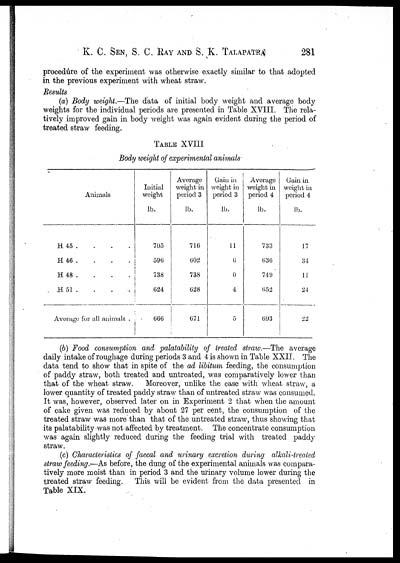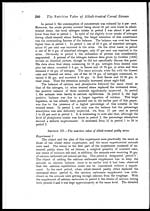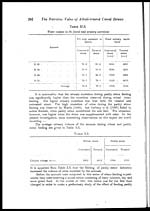Medicine - Veterinary > Veterinary colleges and laboratories > Indian journal of veterinary science and animal husbandry > Volume 12, 1942 > Original articles > Nutritive value of alkali-treated cereal straws
(315) Page 281
Download files
Individual page:
Thumbnail gallery: Grid view | List view

K. C. SEN, S. C. RAY AND S. K. TALAPATRA 281
procedure of the experiment was otherwise exactly similar to that adopted
in the previous experiment with wheat straw.
Results
(a) Body weight.—The data of initial body weight and average body
weights for the individual periods are presented in Table XVIII. The rela-
tively improved gain in body weight was again evident during the period of
treated straw feeding.
TABLE XVIII
Body weight of experimental animals
|
Animals |
Initial |
Average- |
Gain in |
Average |
Gain in |
|
lb. |
lb. |
lb. |
lb. |
lb. |
|
|
H 45 . . . . |
705 |
716 |
11 |
733 |
17 |
|
H 46 . . . . |
596 |
602 |
6 |
636 |
34 |
|
H 48 . . . . |
738 |
738 |
0 |
749 |
11 |
|
H 51 . . . . |
624 |
628 |
4 |
652 |
24 |
|
Average for all animals . |
666 |
671 |
5 |
693 |
22 |
(b) Food consumption and palatability of treated straw.—The average
daily intake of roughage during periods 3 and 4 is shown in Table XXII. The
data tend to show that in spite of the ad libitum feeding, the consumption
of paddy straw, both treated and untreated, was comparatively lower than
that of the wheat straw. Moreover, unlike the case with wheat straw, a
lower quantity of treated paddy straw than of untreated straw was consumed.
It was, however, observed later on in Experiment 2 that when the amount
of cake given was reduced by about 27 per cent, the consumption of the
treated straw was more than that of the untreated straw, thus showing that
its palatability was not affected by treatment. The concentrate consumption
was again slightly reduced during the feeding trial with treated paddy
straw.
(c) Characteristics of faecal and urinary excretion during alkali-treated
straw feeding.—As before, the dung of the experimental animals was compara-
tively more moist than in period 3 and the urinary volume lower during the
treated straw feeding. This will be evident from the data presented in
Table XIX.
Set display mode to: Large image | Zoom image | Transcription
Images and transcriptions on this page, including medium image downloads, may be used under the Creative Commons Attribution 4.0 International Licence unless otherwise stated. ![]()
| Permanent URL | https://digital.nls.uk/75318993 |
|---|
| Description | Covers articles from 1942. |
|---|




